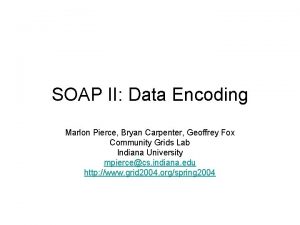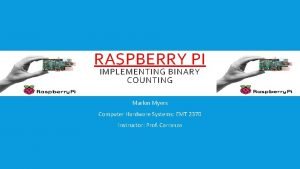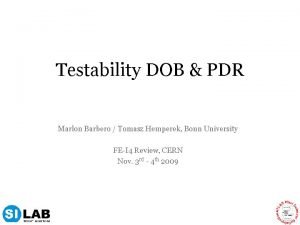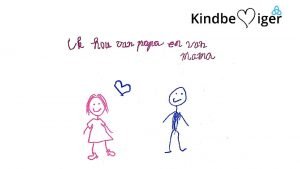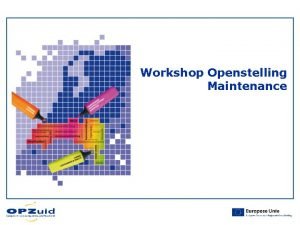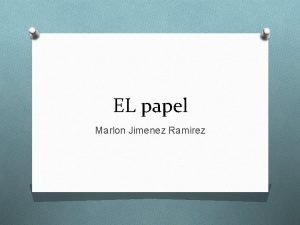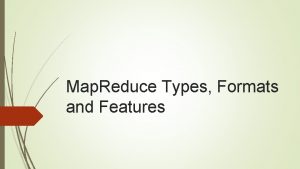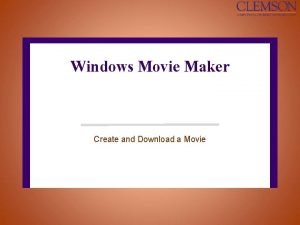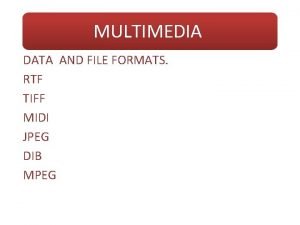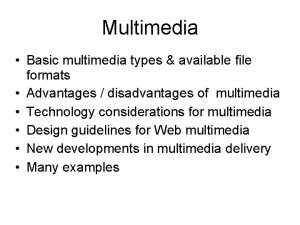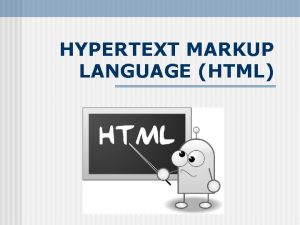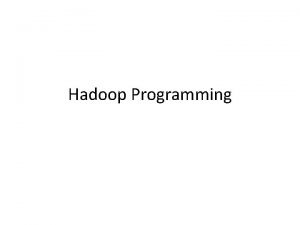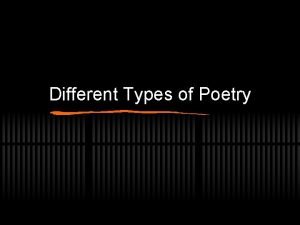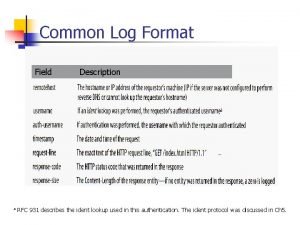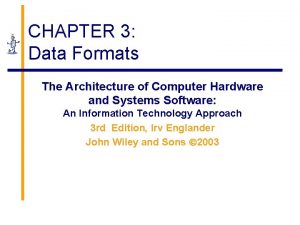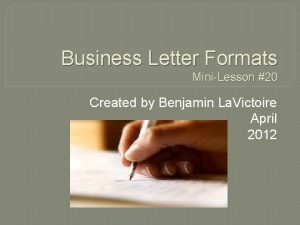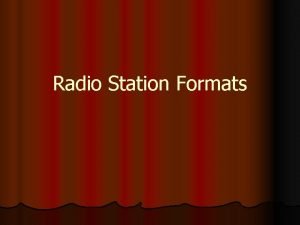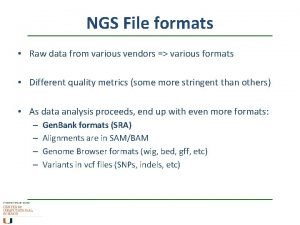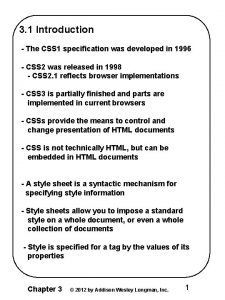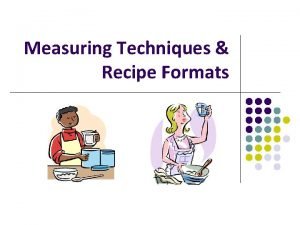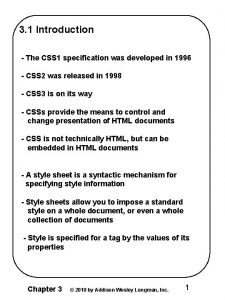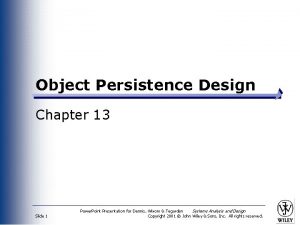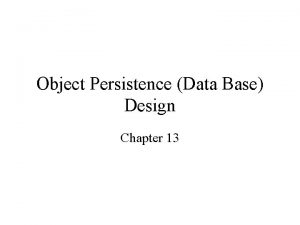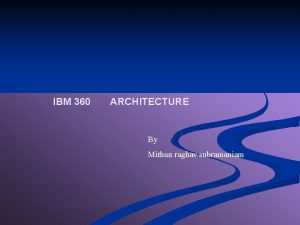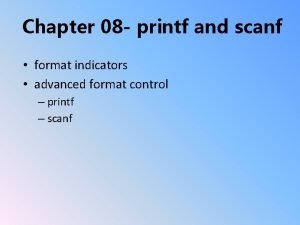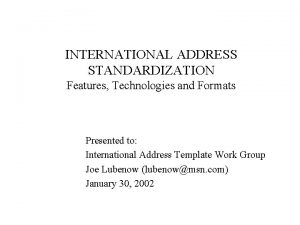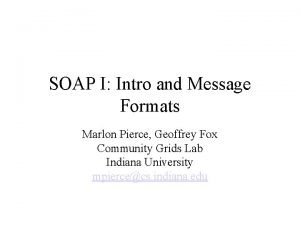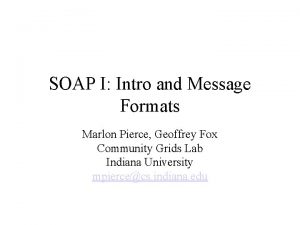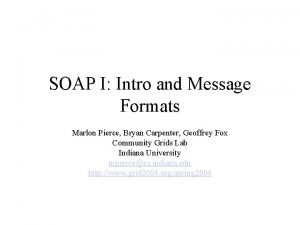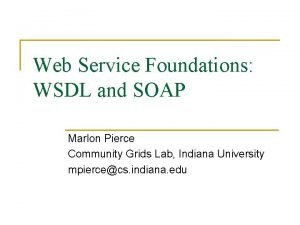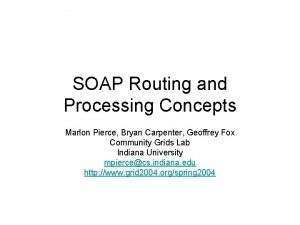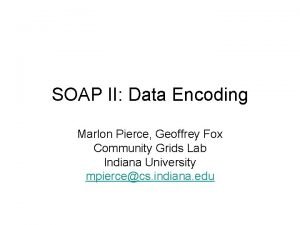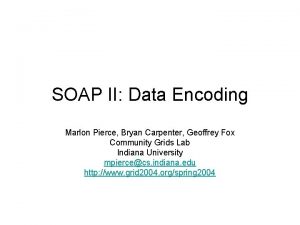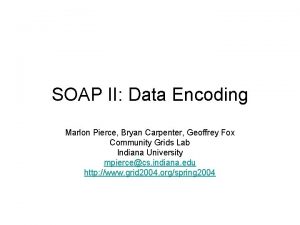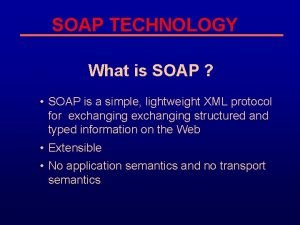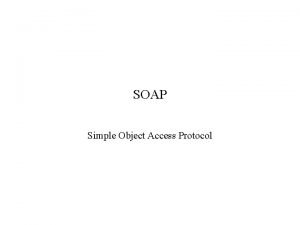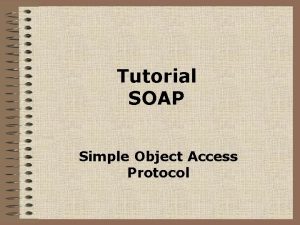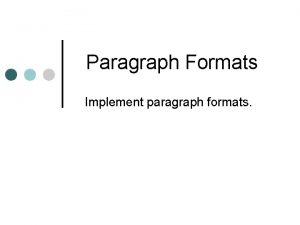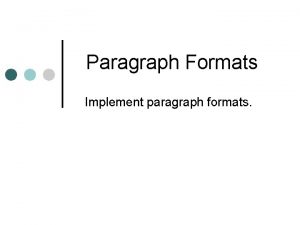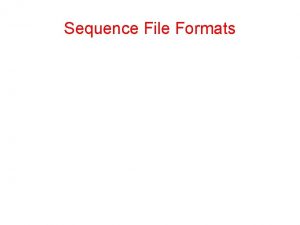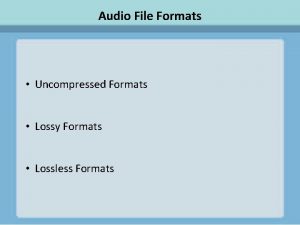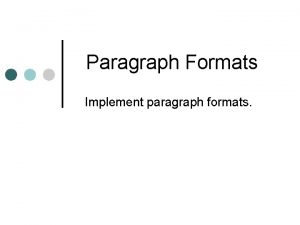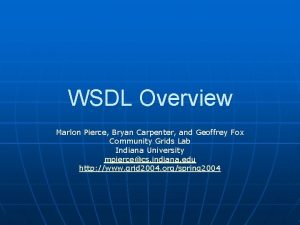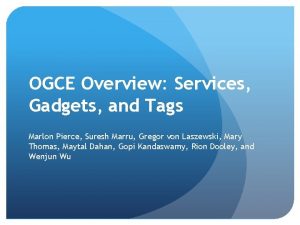SOAP I Intro and Message Formats Marlon Pierce






































- Slides: 38

SOAP I: Intro and Message Formats Marlon Pierce, Bryan Carpenter, Geoffrey Fox Community Grids Lab Indiana University mpierce@cs. indiana. edu http: //www. grid 2004. org/spring 2004

SOAP Primary References • SOAP is defined by a number of links – http: //www. w 3. org/TR/soap/ • See primarily the “Primer” and “Messaging Framework” links. • The actual SOAP schema is available from http: //www. w 3. org/2003/05/soap-envelope/ – It is pretty small, as these things go.

SOAP and Web Services • Our previous lectures have looked at WSDL – Defines the interfaces for remote services. – Provides guidelines for constructing clients to the service. – Tells the client how to communicate with the service. • The actual communications are encoded with SOAP. – Transported by HTTP Client WSDL SOAP Request SOAP Response WSDL Service

Defining SOAP Messages • Given what you have learned about WSDL, imagine it is your job to design the message interchange layer. – What are the requirements? • Note SOAP actually predates WSDL, so this is in reverse order.

Web Service Messaging Infrastructure Requirements? • Define a message format – Define a messaging XML schema – Allow the message to contain arbitrary XML from other schemas. • Keep It Simple – Messages may require advanced features like security, reliability, conversational state, etc. – KISS, so don’t design these but do design a place where this sort of advanced information can go. • • Tell the message originator is something goes wrong. Define data encodings – That is, you need to tell the message recipient the types of each piece of data. • Define some RPC conventions that match WSDL – Your service will need to process the message, so you need to provide some simple conventions for matching the message content to the WSDL service. • Decide how to transport the message. – Generalize it, since messages may pass through many entities. • Decide what to do about non-XML payloads (movies, images, arbitrary documents).

SOAP Lecture Parts • SOAP Messages: – Headers and body elements with examples. • SOAP Encoding: – Rules for encoding data. – Focus on SOAP for RPC • SOAP Routing and Processing • SOAP Over HTTP: – How SOAP gets sent over the wire.

SOAP Messaging

SOAP Basics • SOAP is often thought of as a protocol extension for doing Remote Procedure Calls (RPC) over HTTP. – This is how we will use it. • This is not completely accurate: SOAP is an XML message format for exchanging structured, typed data. – It may be used for RPC in client-server applications – May be used to send XML documents – Also suitable for messaging systems (like JMS) that follow one-tomany (or publish-subscribe) models. • SOAP is not a transport protocol. You must attach your message to a transport mechanism like HTTP.

What Does SOAP Look Like? • The next two slides shows examples of SOAP message. – It’s just XML • First slide is an example message that might be sent from a client to the echo service. • Second slide is an example response. – I have highlighted the actual message payload.

SOAP Request <? xml version=‘ 1. 0’ ? > <soapenv: Envelope xmlns: soapenv="http: //schemas. xmlsoap. org/soap/envelope/" xmlns: xsd=http: //www. w 3. org/2001/XMLSchema xmlns: xsi="http: //www. w 3. org/2001/XMLSchema-instance"> <soapenv: Body> <ns 1: echo soapenv: encoding. Style="http: //schemas. xmlsoap. org/soap/encoding/" xmlns: ns 1="http: //. . . /axis/services/Echo. Service"> <in 0 xsi: type="xsd: string">Hello World</in 0> </ns 1: echo> </soapenv: Body> </soapenv: Envelope>

SOAP Response <? xml version=‘ 1. 0’ ? > <soapenv: Envelope xmlns: soapenv=http: //schemas. xmlsoap. org/soap/envelope/ xmlns: xsd=http: //www. w 3. org/2001/XMLSchema xmlns: xsi="http: //www. w 3. org/2001/XMLSchema-instance"> <soapenv: Body> <ns 1: echo. Response soapenv: encoding. Style=http: //schemas. xmlsoap. org/soap/encoding/ xmlns: ns 1="http: //. . /axis/services/echo. Service"> <echo. Return xsi: type=“String“> Hello World</echo. Return> </ns 1: echo. Response> </soapenv: Body> </soapenv: Envelope>

SOAP Structure • SOAP structure is very simple. – 0 or more headers elements – 1 body element – Envelop that wraps it all. • Body contains XML payload. • Headers are structured the same way. – Can contain additional payloads of “metadata” – Security information, quality of service, etc. Envelope Header #0 Header #1 Body Message Payload

SOAP Schema Notes • All of this is expressed formally in the SOAP schema. • XML on the right is taken directly from the SOAP schema. • This just encodes the previously stated rules. • Also, note that the SOAP envelope can contain other attributes. – <any. Attribute> tag is the wildcard <xs: complex. Type name="Envelope"> <xs: sequence> <xs: element ref="tns: Header" min. Occurs="0" /> <xs: element ref="tns: Body" min. Occurs="1" /> </xs: sequence> <xs: any. Attribute namespace="##other" process. Contents="lax" /> </xs: complex. Type>

Options on <xsd: any/> (From DBC’s Schema Lectures) • The <xsd: any/> element takes the usual optional max. Occurs, min. Occurs attributes. • Allows a namespace attribute taking one of the values: – ##any (the default), – ##other (any namespace except the target namespace), – List of namespace names, optionally including either ##target. Namespace or ##local. Controls what elements the wildcard matches, according to namespace. • It also allows a process. Contents attribute taking one of the values strict, skip, lax (default strict), controlling the extent to which the contents of the matched element are validated.

Lax • “If the item, or any items among its children if it's an element information item, has a uniquely determined declaration available, it must be ·valid· with respect to that definition. ” • That is, ·validate· where you can, don't worry when you can't.

SOAP Envelop • The envelop is the root container of the SOAP message. • Things to put in the envelop: – Namespaces you will need. • http: //schemas. xmlsoap. org/soap/envelope is required, so that the recipient knows it has gotten a SOAP message. • Others as necessary – Encoding rules (optional) • Specific rules for deserializing the encoded SOAP data. • More later on this. • Header and body elements. – Headers are optional, body is mandatory. – Headers come first in the message, but we will look at the body first.

SOAP Headers • SOAP Body elements contain the primary message contents. • Headers are really just extension points where you can include elements from other namespaces. – i. e. , headers can contain arbitrary XML. • • Headers may be processed independently of the body. Headers may optionally define encoding. Style. Headers may optionally have a “role” attribute Header entries may optionally have a “must. Understand” attribute. – must. Understand=1 means the message recipient must process the header element. – If must. Understand=0 or is missing, the header element is optional.

Header Definition From SOAP Schema <xs: element name="Header" type="tns: Header" /> <xs: complex. Type name="Header"> <xs: annotation> <xs: documentation>Elements replacing the wildcard MUST be namespace qualified, but can be in the target. Namespace</xs: documentation> </xs: annotation> <xs: sequence> <xs: any namespace="##any" process. Contents="lax" min. Occurs="0" max. Occurs="unbounded" /> </xs: sequence> <xs: any. Attribute namespace="##other" process. Contents="lax" /> </xs: complex. Type>

Example Uses of Headers • Security: WS-Security and SAML place additional security information (like digital signatures and public keys) in the header. • Quality of Service: SOAP headers can be used if we want to negotiate particular qualities of service such as reliable message delivery and transactions. – We will look at reliable messaging in detail in a future lecture. • Session State Support: Many services require several steps and so will require maintenance of session state. – Equivalent to cookies in HTTP. – Put session identifier in the header.

Example Header from SOAP Primer <? xml version='1. 0' ? > <env: Envelope xmlns: env="http: //www. w 3. org/2003/05/soap-envelope"> <env: Header> <m: reservation xmlns: m=“…" env: role="http: //www. w 3. org/2003/05/soap-envelope/role/next" env: must. Understand="true"> <m: reference>uuid: 093 a 2 da 1 -q 345 -739 r-ba 5 d-pqff 98 fe 8 j 7 d </m: reference> <m: date. And. Time>2001 -11 -29 T 13: 20: 00. 000 -05: 00 </m: date. And. Time> </m: reservation> <n: passenger xmlns: n=“…" env: role="http: //www. w 3. org/2003/05/soap-envelope/role/next" env: must. Understand="true"> <n: name>Åke Jógvan Øyvind</n: name> </n: passenger> </env: Header>

Explanation of Header Example • In this particular case, we may imagine an ongoing transaction for making an airline reservation. – Involves several steps and messages, so client must remind the server of this state information when sending a message. – The actual header content all comes from other namespaces. • The role and must. Understand attributes are from SOAP.

Header Processing • SOAP messages are allowed to pass through many intermediaries before reaching their destination. – Intermediary=some unspecified routing application. – The final destination processes the body of the message. • Headers are allowed to be processed independently of the body. – May be processed by intermediaries. • This allows an intermediary application to determine if it can process the body, provide the required security, session, or reliability requirements, etc.

Header Roles • SOAP nodes may be assigned role designations. • SOAP headers then specify which role or roles should process. • Standard SOAP roles: – None: SOAP nodes MUST NOT act in this role. – Next: Each SOAP intermediary and the ultimate SOAP receiver MUST act in this role. – Ultimate. Receiver: The ultimate receiver MUST act in this role. • In our example, all nodes must process the header entries.

SOAP Body • Body entries are really just placeholders for XML from some other namespace. • The body contains the XML message that you are transmitting. • It may also define encoding. Style, just as the envelop. • The message format is not specified by SOAP. – The <Body></Body> tag pairs are just a way to notify the recipient that the actual XML message is contained therein. – The recipient decides what to do with the message.

SOAP Body Element Definition <xs: element name="Body" type="tns: Body" /> <xs: complex. Type name="Body"> <xs: sequence> <xs: any namespace="##any" process. Contents="lax" min. Occurs="0“ max. Occurs="unbounded" /> </xs: sequence> <xs: any. Attribute namespace="##other" process. Contents="lax" /> </xs: complex. Type>

SOAP Body Example <soapenv: Body> <ns 1: echo soapenv: encoding. Style= "http: //schemas. xmlsoap. org/soap/encoding/" xmlns: ns 1= "http: //. . . /axis/services/Echo. Service"> <in 0 xsi: type="xsd: string">Hello World</in 0> </ns 1: echo> </soapenv: Body.

Example SOAP Body Details • The <Body> tag is extended to include elements defined in our Echo Service WSDL schema. • This particular style is called RPC. – Maps WSDL bindings to SOAP body elements. – Guidelines will be given in next lecture. • xsi-type is used to specify that the <in 0> element takes a string value. – This is data encoding – Data encoding rules will also be examined in next lectures.

When Things Go Wrong • One of the precepts of distributed computing is that things will go wrong in any operational system. – Servers will fail, networks will go down, services will change or go away. • Need a way to communicate failures back to message originators. – Consider HTTP faults • • SOAP Provides its own fault communication mechanism. These may be in addition to HTTP errors when we use SOAP over HTTP. • HTTP Error Messages 403 Forbidden 404 Not Found 405 Method Not Allowed 406 Not Acceptable 407 Proxy Authentication Required 408 Request Time-Out 409 Conflict 410 Gone 411 Length Required 412 Precondition Failed 413 Request Entity Too Large 414 Request-URL Too Large 415 Unsupported Media Type 500 Server Error 501 Not Implemented 502 Bad Gateway 503 Out of Resources 504 Gateway Time-Out 505 HTTP Version not supported

SOAP Fault Scenarios • HTTP errors will take precedence. – Involve message transmission problems. • SOAP errors occur during the processing of the message. – HTTP 500 Internal Server Error • Faults can occur when – You sent an improperly formatted message that the service can’t process (an integer instead of a string, for example). – There is a SOAP version mismatch • You sent SOAP 1. 2 and I understand SOAP 1. 0 – You have a “must understand” header that can’t be understood. – You failed to meet some required quality of service specified by a header.

Sample SOAP Fault From SOAP Primer <env: Body> <env: Fault> <env: Code> <env: Value>env: Sender</env: Value> <env: Subcode> <env: Value>rpc: Bad. Arguments</env: Value> </env: Subcode> </env: Code> <env: Reason> <env: Text xml: lang="en-US">Processing error</env: Text> </env: Reason> <env: Detail> <e: my. Fault. Details>. . . </e: my. Fault. Details> </env: Detail> </env: Fault> </env: Body>

Fault Structure from SOAP Schema • Fault messages are included in the <body>. • <Code> and <Reason> are required. • <Node>, <Role>, and <Detail> are optional. <xs: element name="Fault" type="tns: Fault" /> <xs: complex. Type name="Fault“ final="extension"> <xs: sequence> <xs: element name="Code“ type="tns: faultcode" /> <xs: element name="Reason" type="tns: faultreason" /> <xs: element name="Node" type="xs: any. URI“ min. Occurs="0" /> <xs: element name="Role" type="xs: any. URI" min. Occurs="0" /> <xs: element name="Detail“ type="tns: detail" min. Occurs="0" /> </xs: sequence> </xs: complex. Type>

SOAP Fault Codes • These are one of the required subelements of Faults. • They must contain one of the standard fault code enumerations (next slide). • They may also contain subcodes. – For more detailed error messages. <xs: complex. Type name="faultcode"> <xs: sequence> <xs: element name="Value" type="tns: faultcode. Enum" /> <xs: element name="Subcode" type="tns: subcode" min. Occurs="0" /> </xs: sequence> </xs: complex. Type>

Enumerating Faults • • • Fault codes must contain one of the standard fault messages. Data. Encoding. Unknown: you sent data encoded in some format that I don’t understand. Must. Understand: I don’t support this header. Receiver: message was correct, but receiver could not process for some reason. Sender: message was incorrectly formatted, or lacked required additional information – Couldn’t authenticate you • Version. Mismatch: I don’t support your version of SOAP. <xs: simple. Type name="faultcode. Enum"> <xs: restriction base="xs: QName"> <xs: enumeration value="tns: Data. Encoding. Unkno wn" /> <xs: enumeration value="tns: Must. Understand" /> <xs: enumeration value="tns: Receiver" /> <xs: enumeration value="tns: Sender" /> <xs: enumeration value="tns: Version. Mismatch" /> </xs: restriction> </xs: simple. Type>

Fault Subcodes • Fault codes may contain <env: Code> subcodes that refine the <env: Value>env: Sender message. </env: Value> • Unlike Codes, subcodes <env: Subcode> don’t have standard values. <env: Value>rpc: Bad – Instead, they can take any Arguments QName value. </env: Value> – This is an extensibility mechanism. </env: Subcode> • Subcodes may contain </env: Code> other subcodes.

Fault Reasons • This is intended to provide human readable reasons for the fault. • The reason is just a simple string determined by the implementer. – For Axis, this is the Java exception name. – At least, for my version of Axis. • We must also provide at least one language. <xs: complex. Type name="faultreason"> <xs: sequence> <xs: element name="Text" type="tns: reasontext" min. Occurs="1" max. Occurs="unbounded" /> </xs: sequence> </xs: complex. Type> <xs: complex. Type name="reasontext"> <xs: simple. Content> <xs: extension base="xs: string"> <xs: attribute ref="xml: lang" use="required" /> </xs: extension> </xs: simple. Content> </xs: complex. Type>

Optional Fault Elements • Code and Reason are required. • Node, Role, and Detail are optional • Node and Role are used in SOAP processing steps that we have lightly covered. Source Node 2 – SOAP messages may go through several intermediaries. • Nodes and roles are needed in case a fault occurs in an intermediary. – Return the URI of the node and role • Details will be described. “I Check Auth. Z” Node 1 “I Check Auth. N” Dest.

Fault Detail • A fault detail is just an extension element. – Carries application specific information • It can contain any number of elements of any type. • This is intended for the SOAP implementer to put in specific information. – You can define your own SOAP fault detail schemas specific to your application. • Axis, for example, includes Java exception stack traces. <xs: complex. Type name="detail"> <xs: sequence> <xs: any namespace="##any" process. Contents="lax" min. Occurs="0" max. Occurs="unbounded" /> </xs: sequence> <xs: any. Attribute namespace="##other" process. Contents="lax" /> </xs: complex. Type>

Next Time • This lecture has examined the basic SOAP message format. • We have not described the following: – The rules for encoding transmitted data • Specifically, how do I encode XML for RPC? • How does this connect to WSDL? – The rules for transmitting messages. • I also want to give a specific example of extending SOAP to support reliable messaging.
 Marlon pierce
Marlon pierce Marlon pierce
Marlon pierce Quakesim
Quakesim Marlon is bowling in a tournament and has
Marlon is bowling in a tournament and has Marlon myers
Marlon myers Marlon barbero
Marlon barbero Dr hemperek
Dr hemperek Marlon dijkhuizen
Marlon dijkhuizen Marlon peeters
Marlon peeters Marlon brando cat on a hot tin roof
Marlon brando cat on a hot tin roof Papel afiligranado
Papel afiligranado Language family
Language family Fundamentals of business process management marlon dumas
Fundamentals of business process management marlon dumas Mapreduce types and formats
Mapreduce types and formats Small group stages formats and culture
Small group stages formats and culture Pierce county search and rescue
Pierce county search and rescue Windows movie maker 2012 download
Windows movie maker 2012 download Rapid prototyping data formats
Rapid prototyping data formats Rtf to tiff
Rtf to tiff File formats in multimedia
File formats in multimedia File formats in multimedia
File formats in multimedia Input formats in hadoop
Input formats in hadoop What's a couplet poem
What's a couplet poem Rfc931
Rfc931 Data formats in computer architecture
Data formats in computer architecture Business writing formats
Business writing formats What is the simplest business letter
What is the simplest business letter Radio station music formats
Radio station music formats The term memo is shorthand for which of the following?
The term memo is shorthand for which of the following? Ngs file formats
Ngs file formats Style specification formats
Style specification formats Narrative recipe format
Narrative recipe format Hadoop file formats
Hadoop file formats Style specification formats
Style specification formats Object persistence formats
Object persistence formats Object persistence formats
Object persistence formats Ibm 360 instruction format
Ibm 360 instruction format Scanf formats
Scanf formats International address standardization
International address standardization
